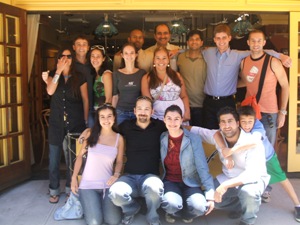|
|
Advocating for UPEACE at the UN
un article par Zahid Shahab Ahmed
I recently took part in a University for Peace (UPEACE) Alumni Advocacy Project at the United Nations from June 17-29, 2007, New York. This project was conceived by a team of UPEACE alumni from ten countries to raise awareness and financial support for UPEACE among UN Permanent Missions, UN agencies, and NGOs.
As alumni, we were uniquely suited to share the UPEACE story, supported by our experience and enthusiasm for the University. The team was composed of professionals like me so as to manifest how academic life at UPEACE added new dimensions to our working lives.

Click on photo to enlarge.
This project was modeled after the youth advocacy teams that the United Network of Young Peacebuilders (UNOY) and Fundacion Cultura de Paz had assembled in the past. We had three days of team-building, followed by a letter writing and fax campaign to set up appointments.
In preparation for the advocacy project, we produced an alumni testimonial booklet to support our efforts. Additionally, we setup an informational booth at UN headquarters for one day to distribute marketing materials and answer questions.
In total the UPEACE alumni advocacy team met with 30 UN missions, 10 UN agencies, and 7 NGOs. The project was highlighted by two events, each with over 100 individuals in attendance. One event was for prospective students and the other for the diplomatic community, NGOs, business leaders, and academics. Both events were highly successful and well received by the participants.
For me I would say that teamwork was critical to our success and the University for Peace was very effective in connecting us as individuals and fostering deep relationships across cultural boundaries.
It was really encouraging not only for me but also for the other team members to find this project being welcomed by not only the UN community, but also by the members of the UN permanent missions and international NGOs. Nevertheless, this is just the beginning and there is a need to have an active follow-up project to ensure that this relationship building with like-minded people and institutions continues.
For a more extensive report, click here. And for further information, please free to contact Nick Martin, co-director of the US association for the University for Peace (UPEACE/US) at nmartin@upeace.org or me at zahmed@upeace.org.
|








|
DISCUSSION
Question(s) liée(s) à cet article:
Youth initiatives for a culture of peace, How can we ensure they get the attention and funding they deserve?
* * * * *
Commentaire le plus récent:
The original Youth Report for a Culture of Peace is still worth reading as the initial inspiration for the Youth Solidarity Fund of the Alliance of Civilizations. See http://decade-culture-of-peace.org/report/YouthReport.pdf.

|
|









